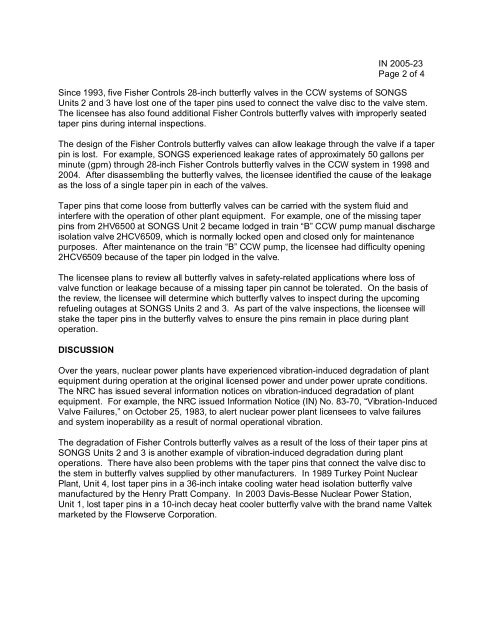in200523 - NRC
in200523 - NRC
in200523 - NRC
You also want an ePaper? Increase the reach of your titles
YUMPU automatically turns print PDFs into web optimized ePapers that Google loves.
IN 2005-23<br />
Page 2 of 4<br />
Since 1993, five Fisher Controls 28-inch butterfly valves in the CCW systems of SONGS<br />
Units 2 and 3 have lost one of the taper pins used to connect the valve disc to the valve stem.<br />
The licensee has also found additional Fisher Controls butterfly valves with improperly seated<br />
taper pins during internal inspections.<br />
The design of the Fisher Controls butterfly valves can allow leakage through the valve if a taper<br />
pin is lost. For example, SONGS experienced leakage rates of approximately 50 gallons per<br />
minute (gpm) through 28-inch Fisher Controls butterfly valves in the CCW system in 1998 and<br />
2004. After disassembling the butterfly valves, the licensee identified the cause of the leakage<br />
as the loss of a single taper pin in each of the valves.<br />
Taper pins that come loose from butterfly valves can be carried with the system fluid and<br />
interfere with the operation of other plant equipment. For example, one of the missing taper<br />
pins from 2HV6500 at SONGS Unit 2 became lodged in train “B” CCW pump manual discharge<br />
isolation valve 2HCV6509, which is normally locked open and closed only for maintenance<br />
purposes. After maintenance on the train “B” CCW pump, the licensee had difficulty opening<br />
2HCV6509 because of the taper pin lodged in the valve.<br />
The licensee plans to review all butterfly valves in safety-related applications where loss of<br />
valve function or leakage because of a missing taper pin cannot be tolerated. On the basis of<br />
the review, the licensee will determine which butterfly valves to inspect during the upcoming<br />
refueling outages at SONGS Units 2 and 3. As part of the valve inspections, the licensee will<br />
stake the taper pins in the butterfly valves to ensure the pins remain in place during plant<br />
operation.<br />
DISCUSSION<br />
Over the years, nuclear power plants have experienced vibration-induced degradation of plant<br />
equipment during operation at the original licensed power and under power uprate conditions.<br />
The <strong>NRC</strong> has issued several information notices on vibration-induced degradation of plant<br />
equipment. For example, the <strong>NRC</strong> issued Information Notice (IN) No. 83-70, “Vibration-Induced<br />
Valve Failures,” on October 25, 1983, to alert nuclear power plant licensees to valve failures<br />
and system inoperability as a result of normal operational vibration.<br />
The degradation of Fisher Controls butterfly valves as a result of the loss of their taper pins at<br />
SONGS Units 2 and 3 is another example of vibration-induced degradation during plant<br />
operations. There have also been problems with the taper pins that connect the valve disc to<br />
the stem in butterfly valves supplied by other manufacturers. In 1989 Turkey Point Nuclear<br />
Plant, Unit 4, lost taper pins in a 36-inch intake cooling water head isolation butterfly valve<br />
manufactured by the Henry Pratt Company. In 2003 Davis-Besse Nuclear Power Station,<br />
Unit 1, lost taper pins in a 10-inch decay heat cooler butterfly valve with the brand name Valtek<br />
marketed by the Flowserve Corporation.
















